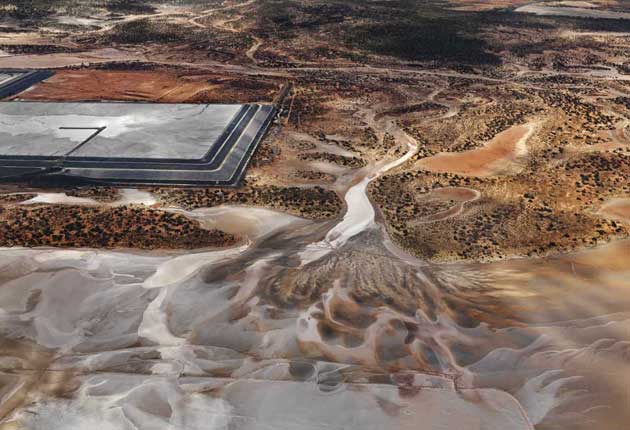Edward Burtynsky: Australian Minescapes, Flowers East, London
A photographer mining a richly dramatic seam

Your support helps us to tell the story
From reproductive rights to climate change to Big Tech, The Independent is on the ground when the story is developing. Whether it's investigating the financials of Elon Musk's pro-Trump PAC or producing our latest documentary, 'The A Word', which shines a light on the American women fighting for reproductive rights, we know how important it is to parse out the facts from the messaging.
At such a critical moment in US history, we need reporters on the ground. Your donation allows us to keep sending journalists to speak to both sides of the story.
The Independent is trusted by Americans across the entire political spectrum. And unlike many other quality news outlets, we choose not to lock Americans out of our reporting and analysis with paywalls. We believe quality journalism should be available to everyone, paid for by those who can afford it.
Your support makes all the difference.These large-format photographs by the Canadian Edward Burtynsky are not so much landscapes as "woundscapes". Burtynsky has been visiting the opencast mines of Australia, and he has photographed what he has seen from a high viewpoint – sometimes from the air, in a helicopter, with a handheld camera. What we see is often unrecognisable as landscape at all because of the sheer brutal scale of the human intervention.
We peer deep into the cavity of a vast gold mine, tier upon tier of rock excavated away so that what is left looks akin to a giant amphitheatre – in some respects, and beneath this pitiless light, it rather resembles what we see in our mouths after a tooth has been pulled. This is something to do with the extraordinary colours of rock, shale and earth, all so dramatically different from each other. The sides of the mine glisten black, like a wet mouth cavity. The earth beyond, in its gentle undulations, looks pure, rich terracotta.
At first, we have no idea of the scale of what we are seeing, nor indeed quite what it is that we are seeing. This could be human viscera. It might be an image from the inside of a human body – one of those images that Mona Hatoum used to take with a tiny camera. Being human, we are inclined to anthropomorphise whatever it is that we see. We want evidence of human presence. We seek out meanings in marks that have no meaning. Pure chance, that's the extent of the meaning. And so it is here, again and again. In the cut-through of a road circling the top of the mine – it looks like a child's dithery outlining of a circle – we seek out symmetry, purpose, pattern.
Elsewhere, we see a strange jagged- looking fork formation scored in the earth. Being anthropologists for the moment, we ache to interpret it as a symbol of some kind. In a photograph of an extraordinary pink salt lake, we see scorings across a plain, and they look like doodles from the hand of Cy Twombly. But there is no thinking at all behind these marks – they are arbitrary tyre-marks.
And this pink salt lake itself is just one of the tonal wonders of these photos. The juxtapositions of colour are so startling they almost beggar belief – can there really be such an aqueous blue beside such a ravishing emerald green, and pushed so close together, on this Earth of ours? Can it be capable of such wondrously daring abstract painting? Well, yes it can, and thanks, in part, to man's ability to wound it.
Then, gradually, we drag our eyes away from the vortex of the deep mine itself, and our eyes rise to take in a wider scene beyond the edge. There is a town out there, strewn, on and on, across the further plain. We can see serried streets, tiny building blocks that must be apartments. So the mine itself, that terrible scarifying of the Earth, must be enormous by comparison with all this sudden presence of the human.
And that is what happens to the presence of the human in these images. It comes upon you suddenly, unexpectedly, comically out of scale, tiny as a pin. The vehicles, too, when we spot them, look ridiculous, squaring up to each other. But the human presence is almost nothing here, in spite of the fact that it is humanity that has made these wounds in the earth, these, terrible, beautiful, sublime gestures that make us wonder with delight one moment, then recoil in horror the next.
To 7 February
Join our commenting forum
Join thought-provoking conversations, follow other Independent readers and see their replies
Comments